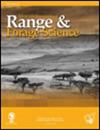Biogeographical patterns of grasses (Poaceae) indigenous to South Africa, Lesotho and Eswatini
IF 1.9
4区 环境科学与生态学
Q3 ECOLOGY
引用次数: 1
Abstract
The ecological and economical importance of African grasses in sustaining animal production prompted studies to quantify the wealth of grass genetic resources indigenous to southern Africa. Plant collection and occurrence data were extracted from two southern African datasets, BODATSA and PHYTOBAS, and analysed to establish biogeographical patterns in the grass flora indigenous to South Africa, Lesotho and Eswatini. A total of 1 648 quarter degree grid cells, representing 674 grass species, were used in an agglomerative hierarchical clustering to determine biogeographical units being referred to as grasschoria. Six distinct groups formed, mainly following existing biome vegetation units, termed the Grassland, Indian Ocean Coastal Belt, Fynbos, Savanna, Central Arid Region and Succulent Karoo grasschoria. The description focuses on associated phytochoria, floristic links, key species, climate and soil properties. The main gradient distinguishing grasschoria was a rainfall-temperature gradient. The collection, conservation and breeding of pasture grass species adapted to especially arid and semi-arid environments, could be managed more efficiently by using these results, but also calling on the need to describe and label infraspecific genetic variants, including ecotypes.南非、莱索托和斯威士兰原产于禾本科植物的生物地理格局
非洲草在维持动物生产方面的生态和经济重要性促使研究量化非洲南部本土草遗传资源的财富。从两个南部非洲数据集(BODATSA和PHYTOBAS)中提取植物采集和发生数据,并对其进行分析,以建立南非、莱索托和斯威士兰本土草区系的生物地理格局。利用1 648个四分之一度网格单元,代表674种禾本科植物,采用聚类分层聚类方法确定禾本科生物地理单元。在原有的生物群落植被单元基础上,形成了6个不同的类群,分别为草原、印度洋海岸带、芬博斯、稀树草原、中部干旱区和多肉卡鲁草甸。描述的重点是相关的植物群落,植物区系联系,关键物种,气候和土壤性质。判别草种的主要梯度是雨量-温度梯度。利用这些结果,可以更有效地管理适应特别干旱和半干旱环境的牧草物种的收集、保护和育种,但也需要描述和标记包括生态型在内的种内遗传变异。
本文章由计算机程序翻译,如有差异,请以英文原文为准。
求助全文
约1分钟内获得全文
求助全文
来源期刊

African Journal of Range & Forage Science
ECOLOGY-ENVIRONMENTAL SCIENCES
CiteScore
4.00
自引率
14.30%
发文量
35
审稿时长
>12 weeks
期刊介绍:
The African Journal of Range & Forage Science is the leading rangeland and pastoral journal in Africa. The Journal is dedicated to publishing quality original material that advances rangeland ecology and pasture management. The journal aims to publish research of international importance from any region, but as an African journal, we are particularly interested in research from Africa and relevant to the continent. The Journal promotes both science and its application and authors are encouraged to explicitly identify the practical implications of their work. Peer-reviewed research papers and research notes deal primarily with all aspects of rangeland and pasture ecology and management, including the ecophysiology and biogeochemistry of rangelands and pastures, terrestrial plant–herbivore interactions (both domestic and wild), rangeland assessment and monitoring, effects of climate change on rangelands, rangeland and pasture management, rangeland rehabilitation, ecosystem services in support of production, conservation and biodiversity goals, and the identification and development of intensive and semi-intensive pasture and forage resources to meet livestock production needs. Articles highlighting transdisciplinary linkages among biophysical and social sciences that support management, policy and societal values are particularly encouraged. The Journal includes relevant book reviews and invited perspectives that contribute to the development of range and forage science. Letters to the editor that debate issues raised in the Journal are acceptable. The African Journal of Range & Forage Science is the official journal of the Grassland Society of Southern Africa.
 求助内容:
求助内容: 应助结果提醒方式:
应助结果提醒方式:


